20 Birds with Yellow Breasts (with Pictures)
Last Updated on

If you are an avid birdwatcher, you’ve probably wondered a lot about the different types of birds out there. For example, you might have wondered about all the birds with yellow breasts.
Of course, birds with yellow coloring are super easy to spot, but there are quite a few of them out there, so how do you tell the difference?
In this list, we will give you 20 of the most common birds with yellow breasts so that the next time you see a yellow-breasted bird, you will be able to tell a Warbler from a Meadowlark and more.

The 20 Birds with Yellow Breasts
1. Western Meadowlark
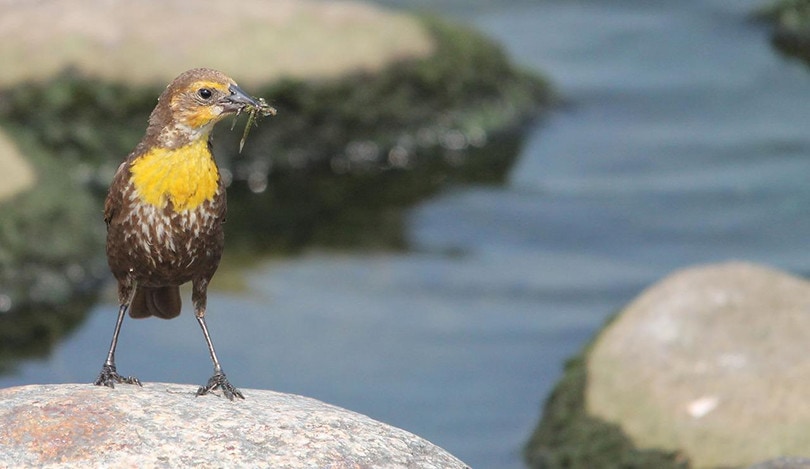
| Length: | 6.3–10.2 inches |
| Weight: | 3.1–4.1 ounces |
| Wingspan: | 16.1 inches |
The Western Meadowlark is a bird with a bright yellow breast and a song that will make anyone smile on a bright spring morning. This bird is so popular that it’s been named the state bird for six different states in the United States, probably because of its song.
This bird breeds in the Northern United States and also in Canada, then it moves to the warmer, southern states. They tend to gather in meadows, fields, and grasslands so they can find seeds and insects to feast on.
2. Prairie Warbler

| Length: | 4.3 inches |
| Weight: | 0.2–0.3 ounces |
| Wingspan: | 2.1–2.9 inches |
The Prairie Warbler is a small-sized songbird that can be recognized by its yellow breast and olive-green back. They breed everywhere in the southeast and northeast states. They spend the winter in Florida or the Caribbean.
Even though they are named Prairie Warblers, they actually live in forests and fields where it’s easy for them to forage.
3. Orchard Oriole Female

| Length: | 5.9–7.1 inches |
| Weight: | 0.6–1.0 ounces |
| Wingspan: | 9.8 inches |
The Orchard Oriole Female is a greenish-yellow color overall with darker wings than the male of the species. They breed in the eastern and central states during the summer season, then they migrate to Central America or south of Mexico.
They live in open woodlands, on farms, and along the riverbanks in pouch-shaped nests that hang over the water. They mainly eat caterpillars, ants, grasshoppers, beetles, and spiders. They will drink nectar from flowers and occasionally snack on fruit.
If you wish to attract this bird to your feeder, use cut oranges or mangos and place them in a platform feeder for the best results.
4. Audubons Oriole

| Length: | 7.5–9.4 inches |
| Weight: | 1.1–1.9 ounces |
| Wingspan: | 12.6 inches |
The Audubons Oriole is bright yellow and black, with a black throat and head. These birds live in Mexico and Southeastern Texas. This is a small range for the birds, and they don’t migrate for the winter.
These birds are primarily found in thickets and areas with woods. They will come to your feeders if you have sunflower seeds and nectar for them to munch on.
They can also be shy, so they might be hard to spot.
5. Eastern Meadowlark
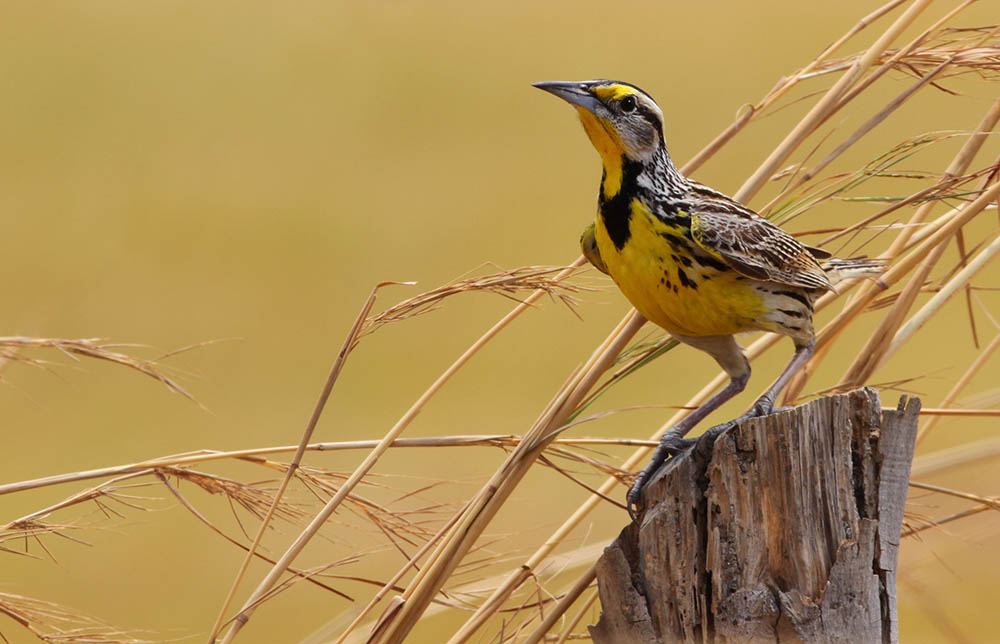
| Length: | 7.5–10.2 inches |
| Weight: | 3.2–5.3 ounces |
| Wingspan: | 13.8–15.8 inches |
The Eastern Meadowlark is a songbird of medium size that is a bright, vibrant yellow underneath. They breed in the northeast and Canada, then migrate to the southern United States, where they stay year-round.
They are most at home when they live in the grasslands or prairies where they can find plenty of insects. In the winter, they tend to gather in large bunches to look for seeds to survive. If you see a large flock of birds in these areas, you’ll know what they are.
6. Evening Grosbeak

| Length: | 6.3–7.1 inches |
| Weight: | 1.9–2.6 ounces |
| Wingspan: | 11.8–14.2 inches |
The Evening Grosbeak is a yellow and black if it’s a male with a white patch on both of its wings. They reside year-round in the Rocky Mountains and Southern Canada.
If the pinecone crops are terrible, you could find an Evening Grosbeak taking food from your bird feeder. They are gorgeous birds so seeing one will be a treat for everyone in the house.
7. Hooded Oriole Female
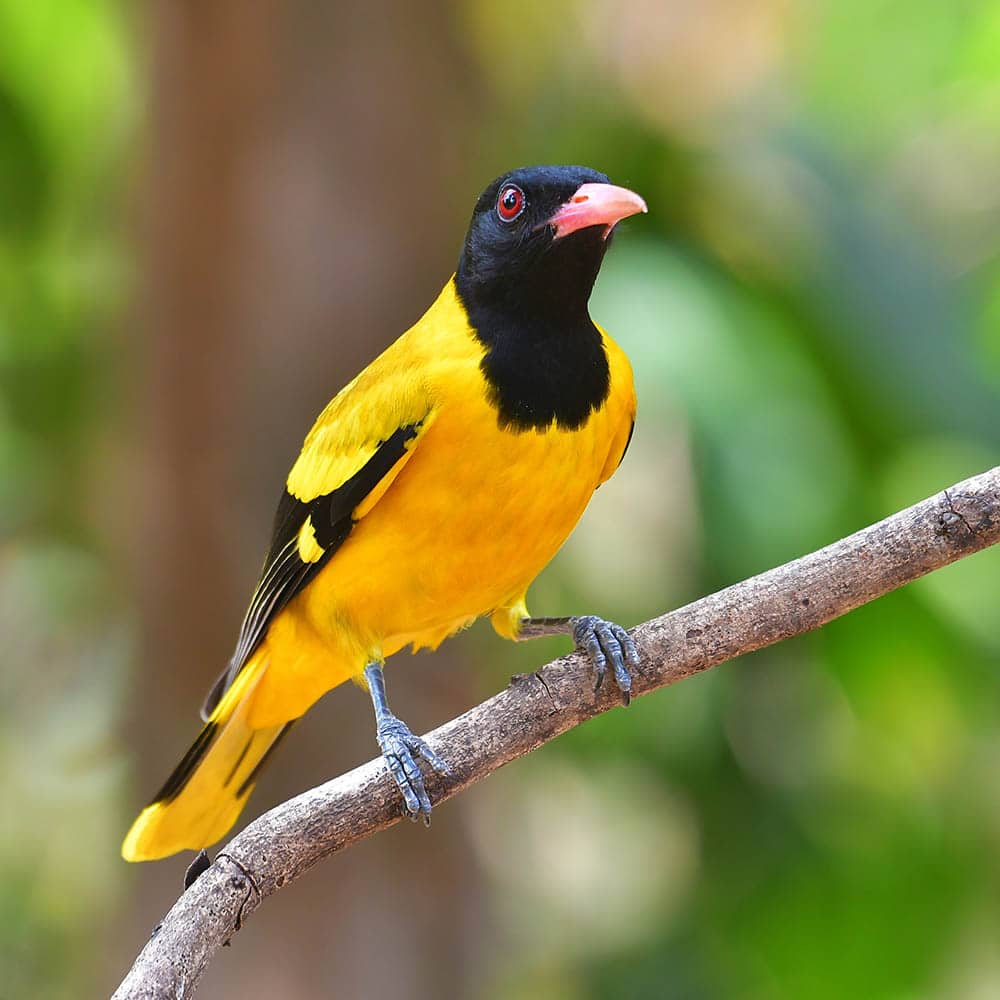
| Length: | 7.1–7.9 inches |
| Weight: | 0.8 ounces |
| Wingspan: | 9.1–11.0 inches |
The Hooded Oriole Female is yellow with gray wings. They make their hanging nests underneath the leaves of palm trees and breed in the southwestern United States. You can use fruit or nectar feeders to attract these birds to your backyard.
8. Hooded Warbler

| Length: | 5.1 inches |
| Weight: | 0.3–0.4 ounces |
| Wingspan: | 6.9 inches |
The Hooded Warbler has a vibrant yellow face with a black throat and hood that are pretty distinctive, so if you see one of these birds, you’ll know what it is. They like forests with dense underbrush so they can easily hunt for insects.
They breed in the eastern states, then head over to Central America and the Caribbean to spend the winter season.
9. American Goldfinch
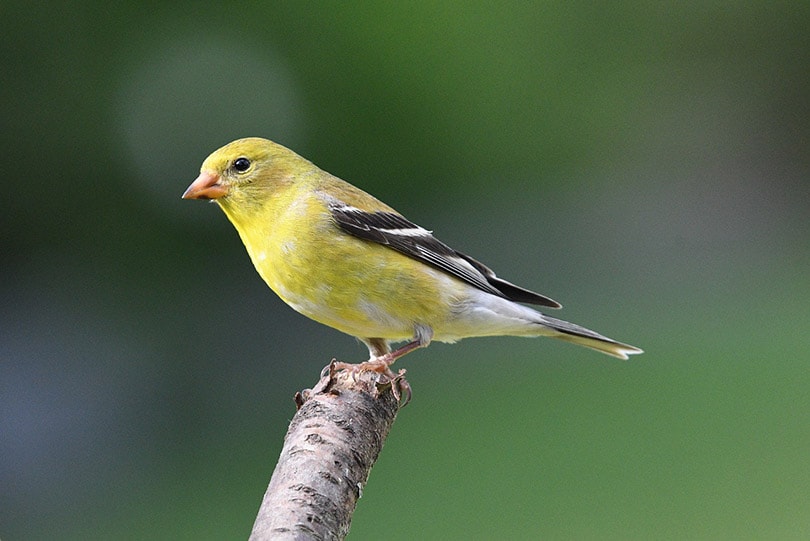
| Length: | 4.3–5.1 inches |
| Weight: | 0.4–0.7 ounces |
| Wingspan: | 7.5–8.7 inches |
The American Goldfinch is a popular bird, but the males are the ones with the yellow breasts. The females are more of a dull brown color. These birds are found in North America after they breed in places like Canada and the midwest. Once they migrate to North America, they stay there for good.
They can be found most often in weedy fields and areas that are overgrown so that they can forage for aster plants, wildflowers, and thistle, which are their favorite meals.
If you keep it filled with sunflower seeds, these birds can be enticed to your bird feeder. You can try planting thistle and milkweed to draw them to your yard as well.
10. Lesser Goldfinch

| Length: | 3.5–4.3 inches |
| Weight: | 0.3–0.4 ounces |
| Wingspan: | 5.9–7.9 inches |
The Lesser Goldfinch is a tiny songbird in yellow and black colors. They have long pointed beaks and stay on the West Coast and in the Southwest year-round. They tend to gather in large flocks in parks, thickets, gardens, and forest clearings. They love seeds, especially sunflower seeds, and also forage for elderberries, coffee berries, and more.
If you’re hoping to entice a Lesser Goldfinch to your yard, try putting nyjer and sunflower seeds into a tube feeder. A platform feeder will entice them as well, as long as it’s adequately stocked.
11. Common Yellowthroat
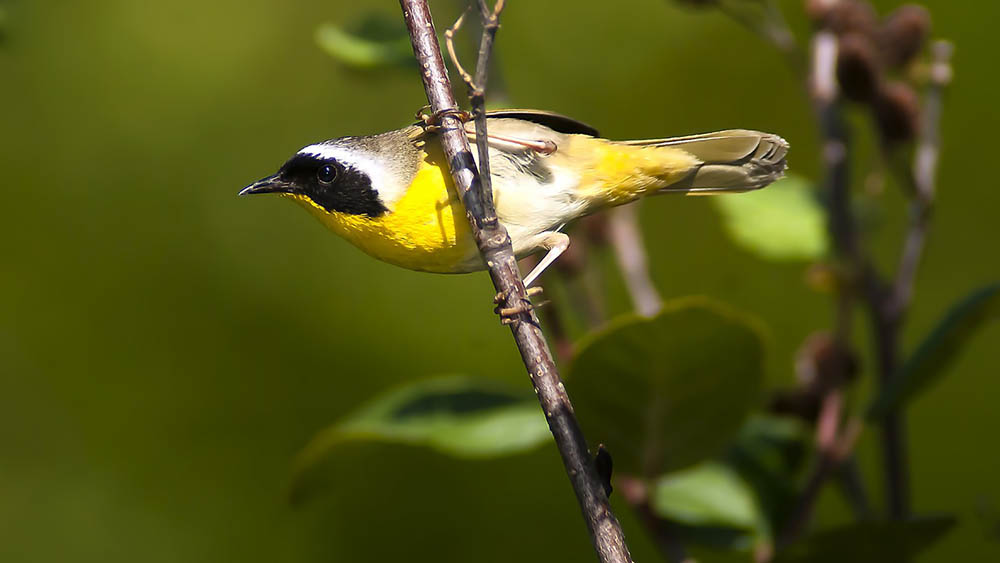
| Length: | 4.3–5.1 inches |
| Weight: | 0.3 ounces |
| Wingspan: | 5.9–7.5 inches |
The Common Yellowthroat is a small songbird with bright yellow breasts and pale-yellow bellies. They breed during the summer across North America, minus Alaska. Some remain along the Gulf Coast or in the Pacific Southwest all year long as well.
They can be found in huge backyards that have plenty of vegetation for them to hunt bugs in.
12. Western Tanager

| Length: | 6.3–7.5 inches |
| Weight: | 0.8–1.3 ounces |
| Wingspan: | 11.5 inches |
The Western Tanager can be easily identified by its yellow body, flaming red-orange head, and its black wings. They breed in Canada and the western states of the US but then can be seen in the winter months in Mexico and Central America.
These birds like to live in forests but also like to stay hidden in the canopy. You might be able to attract one of these bright birds to your feeder by using fruits like cut oranges or dried fruits to entice them.
13. Canada Warbler

| Length: | 4.7–5.9 inches |
| Weight: | 0.3–0.5 ounces |
| Wingspan: | 6.7–8.7 inches |
The Canada Warbler is a bird with a yellow breast and a grey-black back. These birds breed in the northeastern states of America and Canada. However, during migration, they can be seen in the eastern states of the United States as well.
The number of these gorgeous birds is declining, so they are hard to spot. But, if you’re lucky, you’ll spot one in a mossy forest where they forage for insects to eat.
14. Cape May Warbler

| Length: | 4.7–4.1 inches |
| Weight: | 0.4–0.5 ounces |
| Wingspan: | 7.9–8.7 inches |
The Cape May Warbler is different from the rest because of the unusual dark crown and the tiger stripes on its chest. This breed winters in the Caribbean and Central America as well.
You might find them at your feeders in the winter if you have them stocked with fruit and nectar. In the summer, however, they mainly eat spruce budworm.
15. Pine Warbler

| Length: | 5.1–5.5 inches |
| Weight: | 0.3–0.5 ounces |
| Wingspan: | 7.5–9.1 inches |
The Pine Warbler is a tiny, plump bird. They are yellow with backs that are olive in color, and they also have yellow throats. They breed in the northeastern states of America and then head south. Some of the flocks remain year-round in the southern states once they get there.
They live in pine forests, as their name suggests, and can be found foraging for spiders, beetles, caterpillars, and other insects.
When the weather gets cold, they will eat seeds and fruit as well. If you plant native fruits and keep your platform and tube feeders stocked with seeds and fruit, they are apt to visit your yard.
16. Western Kingbird
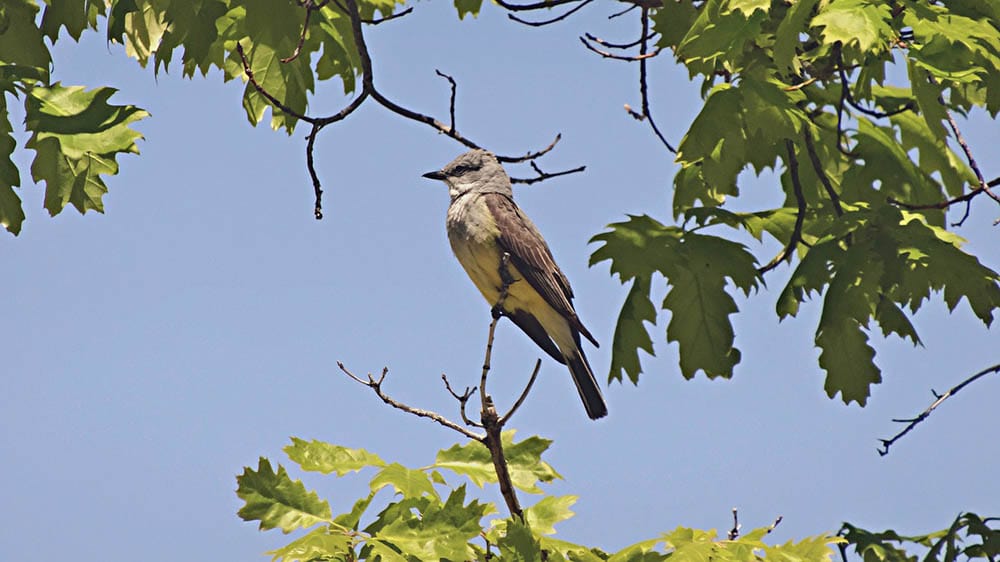
| Length: | 7.9–9.4 inches |
| Weight: | 1.3–1.6 ounces |
| Wingspan: | 15.0–16.1 inches |
The Western Kingbird is a large flycatcher that has a yellow belly, gray and yellow breast, and grayish-brown wings. They breed in the summer in the plains areas of Canada and the western United States. Some will flock to and spend winter in the south of Florida as well.
They nest on the edge of wood lines and also in structures that are made by humans. If you make your yard insect-friendly, then you have more of a chance of attracting this bird to your yard.
17. Altamira Oriole
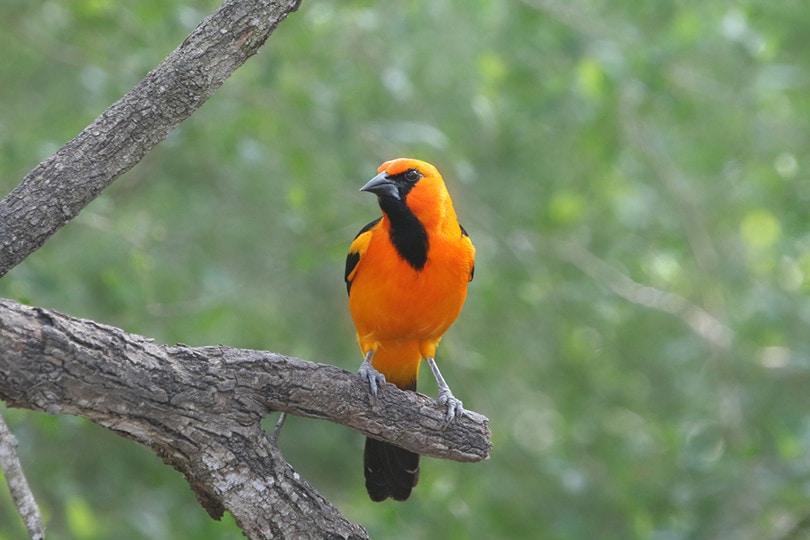
| Length: | 8.3–9.8 inches |
| Weight: | 1.7–2.3 ounces |
| Wingspan: | 14.2 inches |
The Altamira Oriole is a vibrant yellowish-orange bird that has black wings, tails, and a black back. These birds are rare in the United States. They are usually seen most in the Rio Grande Valley in Texas, so if you see one anywhere else, it’s a wonderful sight to behold, especially if you’re a bird lover. They stay in the Rio Grande Valley year-round.
You might be able to find one in backyards at sunflower or even nectar feeders in this area. These birds stay in pairs all year round and live in hanging nests that are as big as 2 feet long.
18. Yellow-Throated Warbler

| Length: | 5.1–5.5 inches |
| Weight: | 0.3–0.4 ounces |
| Wingspan: | 8.3 inches |
The Yellow-Throated Warbler has a yellow breast and black streaks down its sides. While they breed across the southeastern states, these birds spend the winter in Florida, along the Gulf Coast and the Caribbean. Some of these birds flock to and stay in Florida year-round as well.
While they spend most of their time on the tops of pine trees, they have been known to forage lower during their migration period.
19. Palm Warbler

| Length: | 4.7–5.5 inches |
| Weight: | 0.3–0.5 ounces |
| Wingspan: | 7.9–8.3 inches |
The Palm Warbler can be identified by the rusty red patch on the top of its head and its yellow underside. This bird breeds in Canada but then can be found in the eastern states. Finally, however, they often settle in the far south and Florida, where some migrate, and others stay year-round.
In the spring and fall, look for them in forest edges, scrubby areas, and fields with a lot of weeds. They can also be found mixed in with other birds foraging on the ground for insects.
20. Nashville Warbler

| Length: | 4.3–5.1 inches |
| Weight: | 0.2–0.5 ounces |
| Wingspan: | 6.7–7.9 inches |
The Nashville Warbler is yellow with a gray head and a green back. They breed in Canada and the northern states of the US. They can also be found during migration in most states in the US.
They like habitats that are scrubby and also enjoy living in the deciduous forest, where they can easily forage for insects. These are pretty birds that most birdwatchers would love to see during their bird-watching travels.

Conclusion
This concludes our list of the 20 most common birds with yellow breasts. If you’re an avid bird watcher, you might be able to see some of these gorgeous, yellow-breasted birds in your yard if you have the right treats to attract them to your home and feeders.
Featured Image Credit By milesmoody, Pixabay
Table of Contents
- The 20 Birds with Yellow Breasts
- 1. Western Meadowlark
- 2. Prairie Warbler
- 3. Orchard Oriole Female
- 4. Audubons Oriole
- 5. Eastern Meadowlark
- 6. Evening Grosbeak
- 7. Hooded Oriole Female
- 8. Hooded Warbler
- 9. American Goldfinch
- 10. Lesser Goldfinch
- 11. Common Yellowthroat
- 12. Western Tanager
- 13. Canada Warbler
- 14. Cape May Warbler
- 15. Pine Warbler
- 16. Western Kingbird
- 17. Altamira Oriole
- 18. Yellow-Throated Warbler
- 19. Palm Warbler
- 20. Nashville Warbler
- Conclusion
About the Author Patricia Dickson
Patricia is an animal and coffee writer and a published author under the pen name Skylar McKinzie. When she isn’t writing, Patricia enjoys spending time with her two cats and dog. Since she was a young child, she has been a pet lover and enjoys nothing more than cuddling with her pets. Patricia loves sharing her knowledge of animals and finds joy in helping out at the local rescue shelter whenever she can.
Related Articles:
Monocular vs Telescope: Differences Explained (With Pictures)
10 Types of Hummingbirds in Arkansas (With Pictures)
8 Types of Hummingbirds in Nebraska (With Pictures)
5 Types of Hummingbirds in Idaho (With Pictures)
3 Types of Hummingbirds in Mississippi (With Pictures)
8 Types of Hummingbirds in Kansas (With Pictures)
5 Types of Hummingbirds in West Virginia (With Pictures)
5 Types of Hummingbirds in Ohio (With Pictures)
